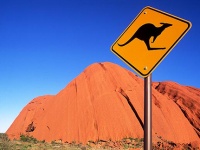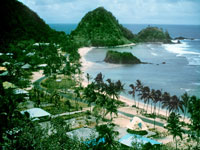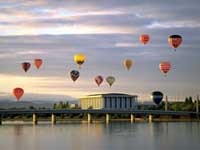Overview Australia

Iconically Australia © Karl Blackwell
Australia is politically divided into six states and two territories, each one offering a different experience for the traveller. There is the drama of the remote 'Outback', the colourful spectacle of the Great Barrier Reef and its coral islands, the excitement of the cosmopolitan cities, the sun and surf at some of the best beaches in the world, and the tropical rainforests of Western Australia. The list is endless in this diverse land of adventure, which boasts 2,000 national parks and 14 World Heritage-listed areas, along with more than 7,000 beaches.
Australia is a land of character too, with its melting pot of cultures. For more than 50,000 years the Aboriginal people lived and thrived in the continent's unique environment. It is believed the Aboriginals are the world's oldest civilisation, and in recent years there has been a resurgence of interest in keeping the Aboriginal culture alive and flourishing.
The vast continent at the bottom of the world was the last landmass to be discovered by European explorers. Captain James Cook arrived in Botany Bay in 1770 and sparked off generations of emigration to Australia, which for some time served as a penal colony. It was not until 1860 that two explorers - Robert Burke and William Wills - became the first Europeans to cross Australia from south to north. The country remains a magnet for modern explorers and adventurers and has a great deal to offer tourists and holidaymakers.
Overview American Samoa

Tutuila in American Samoa © Wikimedia Commons
Inhabited as early as 1000 BC by Polynesian navigators, Samoa was ‘discovered’ by European explorers in the 18th century and occupied by the US in 1900. Not to be confused with Western Samoa, American Samoa comprises six islands located in the Samoan Archipelago halfway between Hawaii and New Zealand and while there is a strong American influence in the islands, American Samoans proudly retain their cultural heritage. It is advisable to respect the Samoan way while visiting their country.
The main island of Tutuila is mountainous and wonderfully scenic with good hiking in the National Park of American Samoa. Transport round the island is cheap and buses operate from the market in Fagatogo. There’s the usual list of attractions including waterfalls, villages, native wildlife, beaches, and archaeological sites to see here. It is also home to the capital and only port of call, Pago Pago, which is both an entertaining and informative village and the US-style stores, restaurants and bars are a refreshing change for anyone who has been travelling the Pacific islands for long.
Boasting some of the most breathtakingly beautiful beaches anywhere in the South Pacific, and a warm and humid climate, there’s plenty of time to explore the biodiversity of marine life found off the shores of the American Samoan islands. One such place is Fagatele Bay National Marine Sanctuary, a tropical reef displaying flamboyant tropical fish, crabs, lobster, sharks and octopus offering exciting snorkelling and diving.
The National park of American Samoa, which is essentially three parks laid out across four extinct volcano islands, offers some of the best scenery from miles of sparkling white shorelines, to some of the most accessible coral reefs and verdant rainforests, such as Lata Mountain on Ta’u, which surpasses all others in its wild and remote forests, free-flowing streams and rugged coastline.
Two small guesthouses on the smaller Ofu and Olosega islands provide affordable accommodation and all the amenities a traveller could need. A local airline flies between Pago Pago and Ofu twice a day. Mosquitoes are about the only nuisance here, and visitors are advised to arm themselves with malaria prophylaxis and repellent.
The weather is warm, the people hospitable and the country exquisitely beautiful and the memory of American Samoa is one that will be relived for years to come by those who visit here.
Capital Territory Travel Guide
The Australian Capital Territory (ACT) was created as a compromise; both Sydney and Melbourne thought that they should be Australia's capital city and the authorities decided that the only answer was to create a new city, within its own territory, between the two rivals. ACT is landlocked in the mountainous state of south-eastern New South Wales; Sydney is 190 miles (306km) to the northwest. The territory is tiny by Australian standards; it is 50 miles (80km) from north to south and about 20 miles (30km) wide. The capital city, Canberra, and its surrounding suburbs are in the northeast of the territory and surrounded by the artificial Lake Burley Griffin; the parliament and other government buildings are located to the south of the lake, and in the north is Civic, where visitors will find the university, the main shopping and business district and most of the nightlife, which, contrary to reputation, is fairly lively. The Namadgi National Park occupies the whole southwestern area of the Territory.
 Why? A holiday in Canberra, Australia's pristine showpiece capital city, is an experience that leaves one with a sense that all is well with the modern world. In a beautiful setting, and packed with attractive buildings and interesting high-class sight-seeing opportunities, those who travel to Canberra find it sophisticated and cultured, but friendly and welcoming.
Why? A holiday in Canberra, Australia's pristine showpiece capital city, is an experience that leaves one with a sense that all is well with the modern world. In a beautiful setting, and packed with attractive buildings and interesting high-class sight-seeing opportunities, those who travel to Canberra find it sophisticated and cultured, but friendly and welcoming.When? A holiday in Canberra can be taken any time of year, with the sun shining over this well-planned city nearly every day. Mid-winter temperatures (June and July) can drop to chilly levels, but the skies usually remain blue. A good time to travel to Canberra on holiday is in early February when the annual National Multicultural Festival, an extravaganza of music and art, is held.
Who for? Anyone interested in the history and politics of Australia, and the country's artistic heritage, will enjoy spending a holiday in Canberra seeing the sights. The city also caters for the more active, offering plenty of recreational opportunities, most centred on lovely Lake Burley Griffin, like kayaking on the lake, or cycling around it.
More Info : To make the most of a Canberra holiday plan ahead with the help of our detailed Canberra travel guide, which lists all the major events and attractions on offer in the city. The travel guide also explains how to get around.Australia's capital city, Canberra, had a difficult birth, punctuated by political infighting, wars and the Great Depression, but it is now a thriving modern city which, together with its surrounds, makes up Australia's Capital Territory. Canberra lies 95 miles (150km) in from the East Coast, by road 175 miles (280km) from Sydney and 415 miles (660km) from Melbourne.
Like most capitals of the world, Canberra boasts an architectural heritage in its civic and Government buildings, but Canberra is also blessed with some of the loveliest surroundings of any national capital. There are more than 30 Australian artistic and cultural institutions located in Canberra, ranging from the Australian War Memorial to Parliament House, surmounted by a colossal stainless-steel flagpole and set in 23 hectares of gardens. In the centre of Lake Burley Griffin, the impressive Captain Cook Memorial Jet shoots a six-ton column of water 482 feet (147m) into the air, while on the shore the National Gallery of Australia houses the country's premier public art collection spanning about 5,000 years of international art.
Canberra is also known for its spring festival, Floriade, when the parks and gardens surrounding Lake Burley Griffin explode with colourful displays of massed tulips and other blooms. The city, with its many parklands, is especially beautiful in spring and autumn.
More --->

